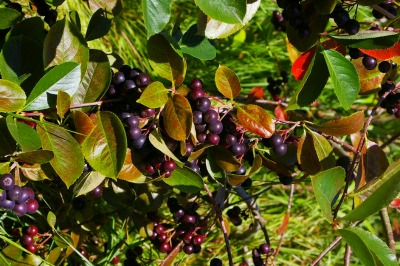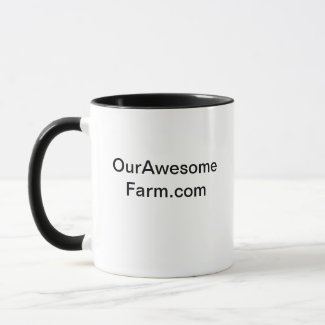The aronia berry -- a potential alternative crop?
Copyright National Lilac Publishing, LLC
A version of this article first appeared in Heirloom Gardening Magazine.
Over the last several years, articles from various news outlets described a special “super fruit” called the aronia berry. Besides its touted health benefits, this fruit also seems special for USA and Canadian growers because it's a North American native plant. No imports from exotic lands necessary. Could aronia berries be a valuable full time or sideline revenue crop for North American eco-farmers?
This
article will cover the aronia variety that produces black fruits which
are more often chosen for growing edible fruits vs. those that produce
red or lighter purple fruits. This darker fruited aronia berry plant is
classified as both Photinia melanocarpa and Aronia melanocarpa, depending
on which taxonomist is being consulted. It’s a deciduous woody
perennial shrub native to eastern North America. It is also commonly
called “black chokeberry.” The latter common name should not be confused
with another American native plant called chokecherry.
Though the aronia fruit looks similar to a dark blueberry and is popularly called a berry, it’s actually a pome (like an apple) vs. a true berry. But it’s widely called aronia berry by both growers and consumers, so that common name will also be used here. In its natural state, it can grow four to more than eight feet high, although those grown for mechanical harvest may be kept shorter and some varieties may even be bred for shorter growth. It needs winter chill to produce fruit.
According to Aronia Berry News (aroniaberrynews.com), “The fruits of A. melanocarpa have been traditionally used by Potawatomi Native Americans to cure colds. In the first half of the 20th century, cultivars of black chokeberry were introduced to the Soviet Union and other European countries, providing fruits used by the food industry. At present, it is used mainly for juice, jam, and wine production, as well as an ornamental plant. Among other substances, the berries of A. melanocarpa contain anthocyanins and procyanidins, possessing strong antioxidative potential. Numerous health-promoting activities—namely, antioxidative, antimutagenic, anticancer, cardioprotective, hepatoprotective, gastroprotective, antidiabetic, anti-inflammatory, antibacterial, antiviral, radioprotective, and immunomodulatory—have been demonstrated for black chokeberry extracts by both in vitro and in vivo studies.”
Aronia once grew abundantly along forest edges, but the clearing of land for commercial agriculture and urbanization has destroyed a lot of its natural habitat on the continent. Yet as stated above, the fruit has flourished under cultivation in other countries. In Russia it was used as a source of Vitamin C the Russians could grow on their own, and has been grown on a large commercial scale there since the 1940s. From there it spread into Europe as a cultivated crop. That’s why one might find varieties of this North American native crop with names seeming to hail from Russia or Europe.
Today,
aronia berry continues as a popular “new” crop in the USA with
potential for growth as a desired food product. In Brooklyn, Wisconsin,
Dale Nelson and William O’Brien formed Bellbrook Berry Farm in 2006,
which they describe as the first commercial planting of aronia in their
state. “Our neighbor, owner of Carandale Farms, was researching unusual
fruit crops,” said O’Brien when asked how the decision was made to start
the aronia berry farm. “He shared his research with us and he thought
aronia would be one of the most commercially viable crops to grow not
only because of its incredibly high nutraceutical value, but also
because it was easy to grow, cold hardy and at that time had no known
pests. My business partner and I looked into it and crunched some
numbers. I located a source of plants and six months later we had two
acres planted. We added acreage every year until we got up to the 12
acres we have now.”
O’Brien and Nelson grow organically, and in 2009, they also opened a nursery along with the farm selling Viking aronia plants. According to these Wisconsin farmers, aronia plants produce best in full sun but will grow in shade as well.
Each
plant has multiple stems per bush once mature, producing loose clusters
of 10 to 15 berries at the end of its shoots, according to Iowa State
University’s Horticulture and Home Pest News. It
further states the buds for the next season’s crops are formed during
the current season’s fruit maturing period. The cultivars are so far
reported self-fertile, so more than one cultivar is not needed to
produce fruit, but only if one wanted to grow fruits with different
qualities or ripening times. In general, aronia ripens in late summer,
and the ripened fruit tends to stay fresh on the plant for an extended
time which can allow for a longer harvest time if desired.
Growing locations and water needs
Aronia is hardy to USDA Hardiness zone 3. It has been known to thrive in or near wetlands in the wild, although for cultivation, well-drained soils are considered the best. Regarding excessively drained soils, however, keep in mind that commercial growers state their cultivars need a steady water supply, even a steady damp soil, including throughout the summer season.
Though aronia has obviously long since survived in the wilds of North America living off natural water sources, and is known to be very adaptable to many conditions, more than one commercial grower supplies steady summer irrigation, especially when the plants are first being established. Irrigation choices, of course, depend on expected rainfall or surface groundwater supply of any given area. But with possible problems with future water sources, it’s something for farmers considering aronia as a cash crop to think about.
Soil conditions
The owners of Bellbrook Berry Farm state that while aronia plants can tolerate a wide range of soil pH conditions -- between 5.3 - 7.5 -- they do best with a slightly acidic pH between 6.1 and 6.7. They recommend both mulch and compost if either of these are available to the grower. They themselves obtain leaf mulch from their local leaf collection service and apply it each fall. Besides adding organic matter to the soil and preserving soil moisture, this also protects the plants from blossoming too early, which could damage the crop if a late frost appeared.
John E. Pilcher is president of Coldbrook Farm, Inc. in Crete, Illinois and also helps educate other aronia berry growers. The farm currently grows 13 acres of Viking aronia berries -- Pilcher states that Viking is the most widely planted aronia variety in the U.S. He shares how he prepared his soil for this crop. “This parcel had been corn-and-beaned to death in annual rotation for decades,” said Pilcher of the land where he now grows aronia. “Before our initial planting in 2009, we had a soil test which showed lower organic matter, pH balance, and trace minerals. We applied limestone with copper sulfate and conventional diammonium phosphate, and disked it in. In late summer, we disked again before planting. For an additional planting adjacent to the first. we planted buckwheat in 2011 over a small area to raise organic matter, then disked it under before planting in late summer. We've used a variety of mulches, including municipal wood chips and ground corn stalks. This year (2016), we'll overseed alsike clover into the grass row middles, which will add nitrogen to the aronia plots.”
For growers in need of an organic phosphate soil supplement, soft rock phosphate or very finely ground rock phosphate mixed into organic manure may work well. But as the Bellbrook farmers point out, a soil test and soil consultant may be worth the investment if a larger planting is planned. Much easier to do soil amendments before the long-standing plants are in the ground.
Plant spacings and harvest
Aronia berries can be harvested by hand or mechanically, depending on whether they’re used just for the homestead, as a u-pick crop, or as a more major mechanically harvested cash crop (more about mechanical harvest below). Preferred plant spacing and plant location choices, of course, are partly determined by how the grower plans to harvest the fruits. The owners of Bellbrook Berry Farm recommend the aronia plants they sell be spaced between two and three feet apart, with 12 to 15 feet between rows, which leaves room for mechanical harvesting equipment. For hand harvesting, they suggest plants be spaced four to six feet apart with 10-foot wide rows. The farmers themselves grow alfalfa and clover between their aronia plants, and they maintain 15 feet between rows.
The owners of Bellbrook Berry Farm didn’t start out with mechanical harvest. “We picked by hand for the first couple years until it became apparent we needed some help,” said O’Brien. We bought a blueberry harvester which worked well. More recently we bought a Polish style aronia and current harvester which we like. We use a 50hp tractor to pull it. It takes two or three people to run it, but we can harvest 3,000 pounds per hour when the going is good.”
Other plant spacings have also been suggested and used on commercial farms. “We used 4-foot in-row plant spacing on both plantings,” said Pilcher of Coldbrook Farm, Inc., “and 11--12-foot row middles on the first planting and 10-foot middles on the second. Because we use a self-propelled over the row harvester, either of the latter works well.”
Aronia has been reported to generally produce about 15 to 20 pounds of fruit per shrub after full maturity in three to five years, although some growers and university trials have reported far higher yields.
Pruning
Aronia plants do sucker and can form colonies or natural hedgerows. Regular pruning is definitely a part of producing high yields of aronia fruit. Because its fruit buds develop the season previous to their maturity, care must be taken to nurture next season’s fruit producing canes while also pruning out older canes that have begun to diminish in production.
Growers in different climate zones, with different varieties and with different goals all have their own methods for pruning that suit them best. Two suggestions for proper pruning include cutting back canes or stems that reach one inch in diameter, or cutting back canes that are four or five years old. If harvesting mechanically, pruning becomes even more important to make sure the plants aren’t too thick or tall to fit through a mechanical harvester. Alternately, for those growing the berries more as a homesteading project without mechanical harvest and without the need for yearly harvests, the entire plant can be cut to the ground every decade, after which it will re-establish itself and produce again in a few years.
Pilcher uses his past training with other fruits to guide his method of managing aronia. “I use the pruning plan that I learned from blueberry growers.” he said. “I prune out older canes after 5 years or so, depending on plant growing conditions over that period. (The year 2012 was a drought year, so there wasn't much growth then.) The blueberry "rule of thumb:" cut out canes thicker than your thumb. Leave 6-10 canes per hill. When plants are still dormant at the end of winter, and before the buds break, I also cut low small lateral branches which won't grow vertically and will be missed by the harvester.”
Pests and diseases
Numerous growers from those with large plantings to those with just one or two plants describe their aronia plants as being relatively pest and disease free. Some garden and small-scale aronia growers have stated that birds can be somewhat of a problem, yet others have never had issues with birds eating the crops, even after years of growing.
“We don't have any problems with birds, never have,” said O’Brien. “But I've heard of a couple people saying they do. I would recommend giving (the birds) an alternative food source, harvesting in a timely fashion, or in the case of a person with only a couple bushes, they could throw a net over them.” He suggested that other creative forms of bird management, even scarecrows, might do the trick.
One thought regarding the timely harvest he suggested includes the fact that the fruits do tend to hang well on the branches after ripening, making their harvest over an extended time practical for hand harvesters, but also available to birds during the cooler late fall or early winter season when other berries might already be finished and gone. According to an article provided by the Arnold Arboretum of Harvard University authored by Mark Brand, “The name chokeberry may have been given to aronia because people have observed that the berries are initially overlooked by birds and are only taken later in the winter when they are the last fruits remaining.” There is the possibility that because commercial aronia growers harvest all their fruits at once in late summer while there are other small fruit choices available for the birds, they don’t experience the birds eating their fruits as often as the hand harvester might.
“A more common issue (than birds) is deer,” O’Brien continued. “One creative way I've heard people deal with deer is to put up a couple lines of monofilament fishing line as a fence. Ha Ha right? Well, the idea here is that the deer don't see it and walk into it. It spooks them out and they stay away.
“We had some deer browse when our plants were young but we don't have an issue anymore. I attribute that to the larger quantity of plants we have and that clover and alfalfa is now established which gives them a tasty alternative.”
He stated that when they first started growing aronia, they didn’t know of any real pests. “But over the last couple years a few bugs have showed up,” he said. “The Japanese beetle, and fruit flies. These can be controlled organically, but monitoring for them is key.
“In growing aronia we have come to learn the more we care for the crop, the better quality berry we will have. That includes nutrient, water, pest, and weed management. Other than that, Mother Nature does the rest.”
For growers who want to consider future potential pests and diseases of aronia for their growing area, they can check with their local agriculture extension agent to see if there is any information on growing aronia in their region. The Iowa State University publication mentioned above, for example, states the following, “While aronia has few serious pest problems, it is not pest free. Deer, birds, rabbits, and small rodents may be a problem. While aronia does release a natural chemical to deter deer browsing, it is not sufficient to protect the plant. A fence or protective barrier is necessary to prevent browsing on young plants. Because aronia is in the same family as apples, they potentially share many of the same pests. Possible insect pests for aronia include apple maggot, brown marmorated stink bug, cherry fruit worm, grasshoppers, Japanese beetle, spotted winged drosophila and tarnished plant bug. These pests are not active in all regions of aronia production, so scouting is important to determine if management is required. Observed diseases include cedar-quince (or hawthorn) rust and cedar-apple rust although healthy aronia plants seem to be very tolerant of these diseases.” The publication further stated that yield would probably not be affected by those diseases in spite of lesions that could appear on the leaves. And that though fire blight may be possible, reported cases have been very rare.
As another example, a publication from the Washington State University’s extension service reported on findings of its previous trials of aronia berry. It stated, “The bushes we have on trial at Mount Vernon, planted in 1998, yielded nearly 27 pounds of clean berries per bush in 2001. The bushes were netted to protect the crop from bird damage, however this does not seem to be a major problem in commercial plantings. The plant is well adapted to many areas of North America, its original home, and appears to be little affected by either pests or disease, so it clearly has potential for use as an alternative commercial fruit crop that may be suited to organic growing.”
As sustainable growers often know, a rarely grown alternative crop can sometimes start out free of pests and diseases when planted in a new area. Over time, new diseases and pests can eventually move in. However, with a diversified planting structure, the natural predators of smaller insect pests can also move in with them if given proper habitat nearby. And healthy soil can help crops fend off damaging disease.
Marketing and products made from aronia berries
With the aronia fruit’s tart, astringent taste, it’s usually consumed in ways that mix it with other foods or additives such as sweeteners, including juices and wines that are sweetened and/or blended with other fruits. If interest from the food industry grows for aronia fruit, the number of products made from it, and ways for the farmer to sell it, may also grow. Some farmers freeze and dry the fruits to sell directly to the consumer. The consumer can then juice or bake the fruits into their own recipes. In the case of drying, the berries are sometimes sweetened enough to allow consumers to enjoy dried arona directly as a snack. Other aronia products produced in various locations include baked goods, supplements, extracts, salsas, gummy treats, teas, and preserves.
Teresa Brockman grows two acres of aronia in Congerville, Illinois that have been certified organic since 2009. She also grows two acres of other fruits, herbs and plant starts produced about five miles away in Eureka, Illinois, which she says are not certified organic, but that she uses organic growing methods with them. Brockman sells value-added aronia products including jams and jellies mostly directly to consumers. “After the berries are picked off the bushes,” she said about her preserve-making process, “they are packed in plastic lugs and loaded onto pallets. The pallets are loaded into a refrigerated truck and brought to a processing plant in Michigan where they are cleaned, sorted, boxed, and frozen. We pick up the berries and store them in a commercial freezer in a nearby city. I take the berries out of frozen storage as I need them.
“I process my jams and jellies at a local church that has a health department inspected kitchen,” she continued. “I had to get my Food Service Sanitation Manager's Certificate and I am inspected by the Illinois Department of Health. I do all the processing myself in small batches. It takes about five to six hours to make about 150 8-ounce jars of jam. I use all organic ingredients unless they are not available (pectin, for example).”
As far as marketing aronia fruits and products, individual aspiring aronia growers may want to determine if enough of the consumers they hope to reach are aware of the benefits of aronia, and if not, would they want to contribute to their potential customers’ (whether local or national) knowledge of the fruit in order to generate eager sales.
Brockman further described her experience in marketing and selling her aronia products. “At first it wasn't that challenging because the harvests were small,” she said. “As the harvests increased in size, I had to start to find ways to get people to buy more fresh aronia and I had to find other ways to sell the aronia besides just fresh berries.
“I direct market all of my fruit crops myself, so I marketed my fresh aronia berries through my Fruit CSA and my farmers' market, just like I do with my other fruits. At first it was a challenge to get customers to try aronia, especially after they sampled the berries plain since they are very tannic and not very palatable to most people. I learned that if I brought samples of foods made with aronia berries, such as muffins, smoothies, cookies, salsa, and gazpacho, that they would be much more receptive. I also provided customers with an oral run-down of all the selling points about aronia--native fruit, locally and organically grown, highest antioxidant fruit native to North America. And I provided customers with recipes and a brochure providing information about aronia and about my farm. All of these strategies helped sell more and more fresh berries each year. People would get "hooked" on certain recipes.
“Since I now have more fresh aronia berries than I can get rid of during the harvest season, I have to process them and sell them in other forms than just fresh berries. I make jam, jelly, and tea, and I freeze berries for packaged frozen aronia berries, and a fresh-pressed aronia juice. All of these products, I market myself mainly to my CSA members and farmers' market customers. A very small amount of the preserves and frozen berries are marketed in small health food stores locally.
Using aronia berries as a homegrown handmade food business with diversified products has served Brockman well so far, but she may need to expand even further. “With all of these processed products,” she said, “so far, I have been able to get rid of my berries by the time the next harvest comes in. I do have to admit though, this was only possible because my harvests were much smaller than anticipated due to various reasons ranging from bird predation to too-long delayed harvests because of difficulty finding custom harvesters. Had those harvests been larger, I would have had to find additional ways to market my berries. In fact, this year I still have a large amount of frozen berries and am probably going to have to find additional outlets for selling my aronia products.”
William O’Brien commented on the current national marketing of aronia. “Aronia seems to be a bit of a different animal when compared to common fruits,” he said. “If you look at blueberries, which arguably taste better, a lot of money has gone into promoting the blueberry industry, and it's a large established market now. Same with cranberries. The aronia industry has a growers’ group and a co-op but there is no aronia marketing board per-say. Aronia has gotten some press, and people who are health oriented are finding out about aronia and seeking it out. That seems to be driving demand at this point. Big food has not shown much interest yet, but if aronia becomes a buzzword then they will all want it on their ingredients list.
“Generally,” he continued, “I see a bright future for aronia, brightest in the health food area, and with the conscious consumer. The aronia industry is still very young. There is much potential. As the number of acres of aronia planted increases, growers will be pushing for more market share. Perhaps this will spur the creation of an aronia marketing board which could help the industry as a whole. Regardless, as people discover the health benefits associated with aronia, this berry will be increasingly in demand. At this point aronia is being introduced to the public through literature, farmers’ markets, CSAs, juice bars, and grocery stores all across the country. It's sort of like a grassroots movement.”
Depending on one's own community, selling to local restaurants may also be a possibility. The attractive, thornless aronia crop also lends itself to marketing via agritourism. Sawmill Hollow, Inc. located in Missouri Valley, Iowa and the first commercial aronia berry farm in the USA, is heavily involved in bringing both local community and more distant tourists to the farm to see the crops, taste aronia value added products, and even learn about aronia farming. In the past, as many as 3000 aronia berry enthusiasts have shown up for their annual North American Aronia Berry Festival, which also shared information on a USA made over-the-row aronia berry harvester.
Each farmer’s potential buyer is different. One region may have few aronia growers, but already have many local consumers well informed or very open to new crops such as this one. Another location’s citizens may project little interest upfront, but the farmer is willing to do a lot of consumer education. One day, this “super berry” from North America may well become generally better known, and may be found by many to be worth adding to their menu of crop offerings, if not becoming their major crop.
_________________
See also our articles on how farmers find ways to fully protect and insure their farm businesses with sometimes very low (or even free) yearly insurance costs:
You may also enjoy
Marketing your farmed products
Start a farmers market or set up a roadside stand












